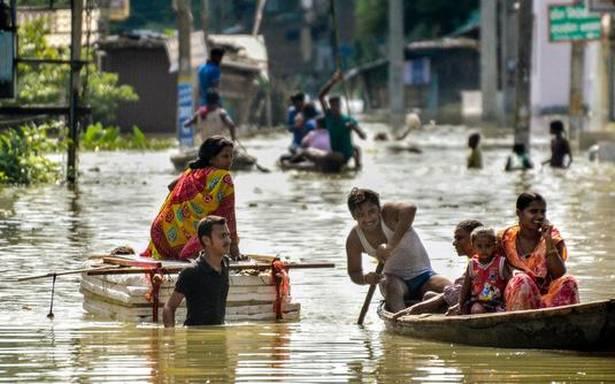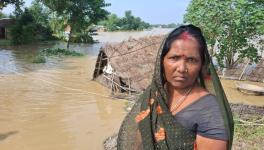Bihar Floods: Thousands Flee Homes, Shift to High Rise Embankments, NHs After Villages Inundated

Image Courtesy: The Hindu
Patna: Amid the worsening COVID-19 pandemic, thousands of people in Bihar have been forced to flee from their thatch and brick homes as flood waters have entered more than a hundred villages. The rising water levels of several rivers are threatening to inundate many other villages in the coming days.
Nearly four lakh people have been affected by the floods in the state till Monday, July 20, as per official data of the state disaster management department. The number of affected people are increasing day by day. There were 2.92 lakh flood affected people on July 18 that increased to more than 3 lakh on July 19.
But unofficial figures have put the number to more than 10 lakh affected people in the state.
It is not only villagers and their livestock that ae badly hit by floods, wild animals are also not left unaffected by the flood. The forest department in East Champaran district informed that they had rescued 74 deers from flood water but nine of them died. “We have handed over 65 deers to officials of wildlife sanctuary at Bettiah in West Champaran,” the district forest officer Lakhendar Pandit told NewsClick.
After heavy rains in Patna on Sunday and Monday, a major part of the capital city is in the grip of water logging. This has also rekindled the fear among residents of last year’s nightmare, when the city had been in the headlines for the worst ever water logging. This year’s rains have again exposed the farce of Nitish Kumar government’s claim that water logging problems have been taken care of.
Water logging in the heart of Patna, one of the aspiring ‘Smart Cities’ has raised eyebrows over repeated claims made by chief minister Nitish Kumar and Deputy Chief Minister Sushil Kumar Modi. Last year, soon after the worst water logging embarrassed both of them, the state government had announced a permanent solution for recurring water logging.
After water logging, dirty water entered the medical wards of Patna-based government-run Nalanda Medical College and Hospital, one of the three designated COVID-19 treatment centres in the state. The local authorities had to pump out the water.
According to official report of the department,156 panchayats in 32 blocks in eight flood-prone districts of Muzaffarpur, Gopalganj, Sitamarhi, Sheohar, Supaul, Kishanganj, Darbhanga, and East Champaran have been affected by the floods. More than 12,845 people from inundated villages have so far been evacuated to safer places, about 1,075 people are staying in five relief camps and 29 community kitchens are running in flood affected areas.
Also read: Bihar: Thousands in Fear of Floods After Erosion Work Delayed Due to COVID-19
Authorities in the flood hit districts have asked people living in vulnerable and low-lying areas to shift to safer places following the rising water level of the rivers .The state government has asked engineers and district officials to keep a round the clock vigil.
But, the flood situation is grim in several other districts including Madhepura, Khagaria, Katihar, Madhubani, Purnea, Araria and Bhagalpur.
The Central Water Commission officials have said that all major rivers including Koshi, Kamla Balan, Bhuthi Balan, Bagmati, Gandak, Mahananda, Burhi Gandak, Adhwara, Lal Bakeya and Ghaghra are maintaining the rising trend and most of them are flowing above the danger mark at few places in different flood prone districts.
Left with no option, poverty stricken people including landless farm labourers, small farmers and others, have taken shelter on high rise river embankments, national highway, school buildings and at other safer places to protect themselves from rising floodwaters. “Fear of devastating floods is giving them some nightmares after water entered their villages, while water level continues to rise in all the major rivers following heavy rains in the state and the catchment areas of Nepal," a water resources department official said.
Sandeep Yadav, president of Koshi Nav Nirnan Manch, said most of these people have been displaced and forced to leave homes after their villages were marooned. Most are staying in temporary arrangements made of plastic sheet by themselves, others have moved to their relatives’ villages, those of which are considered safe.
Officials said the water level in major rivers started receding last week but showing a rising trend again after heavy rains since Saturday. All the rivers are in full spate following heavy rains, posing serious threat to hundreds of thousands of people in low lying areas,near banks of rivers and their embankments.
However, Bihar Water Resources Development Minister Sanjay Jha said all embankments were safe and there was no need to panic. “Our engineers and field officials are monitoring everything and taking all measures to protect embankments,” he said, adding that the eastern Kosi embankment, which was breached in 2008 flooding five districts of northern Bihar, was totally safe.
Jha said the WRD has recently launched “HelloWRD”campaign, a first of its kind in the state. The WRD has urged people in flood prone areas to use a Twitter hashtag of the department to inform or report about any visible cracks or breaches on embankments and point out any shortcomings in flood-prevention structures.
Jha said the department has also launched a 24×7 call centre with a toll free number for the people to help them during floods.
With Patna Meteorological Centre (PMC) last Friday issuing an alert for heavy rainfall for next 72 hours in Bihar, government agencies have warned district administration of a likely food situation. The IMD also issued alert for lightning. In the last 24 hours at least 15 people have been killed by lightining strikes.
Earlier in the second week of July, heavy rains had lashed north Bihar districts bordering Nepal and created a flood like situation after PMC forecast heavy to very heavy rain from July 9 to 12 .
Also read: Why Stronger Efforts are Needed During this Flood Season
Fear of floods and flash floods with the onset of the monsoon is not new in Bihar. What has worried thousands of people is that flood control measures were not completed till June 25 . The government has been citing lockdown due to the COVID-19 pandemic as a reason for the delayed work which was completed in hurry to meet extended deadlines.
After the lockdown began on March 25, most of the anti-erosion work, including projects for embankment repair and maintenance, came to a standstill which lasted till mid-May. Work resumed only after the government eased the lockdown.
This reality is reflected on-ground as anti-erosion work is still on, with an urgency to complete it by June 30 at any cost. However, the monsoon had hit the state on June 13. Anti-erosion work was initially supposed to have been completed by May 15. So far, 350 of a total of 388 anti-erosion and flood protection works have been completed, and work is underway on the others, officials said.
According to the official website of the Water Resources Department, Bihar is the most flood-affected state of the country, accounting for close to 17.2% of the total flood-prone area in the country. Out of 94.16 lakh ha of geographical area, 68.80 lakh ha (76% of North Bihar and 73% of South Bihar) is flood prone. Presently, 28 out of 38 districts of Bihar are flood-prone.
The flood management works which can be carried out include the construction and maintenance of embankments, revetment in selected portions of river banks, land spurs and other necessary flood-protection work. A large part of river catchments fall in the glacial regions of the great Himalayas. Thus, remedial measures for flood protection in Bihar are critical.
As a long term measure, the construction of storage reservoirs and extensive watershed treatment in the upper catchments of rivers is being seen as essential. For the short-term, the construction of embankments along the rivers was done; by constructing about 3,745.96 kms of embankment, around 36.46 lakh ha of area has been brought under a reasonable degree of protection. The existing embankments are under increasing pressure due to the rise in the river bed levels due to heavy silt brought down by the rivers from Nepal. Due to abnormal changes in river courses, anti-erosion work for the protection of embankments, and essential flood-fighting work, is imperative each year.
Get the latest reports & analysis with people's perspective on Protests, movements & deep analytical videos, discussions of the current affairs in your Telegram app. Subscribe to NewsClick's Telegram channel & get Real-Time updates on stories, as they get published on our website.























